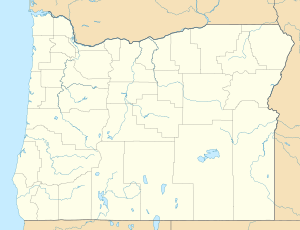Spring River (North Umpqua River tributary) facts for kids
Quick facts for kids Spring River |
|
|---|---|
|
Location of the mouth of the Spring River in Oregon
|
|
| Country | United States |
| State | Oregon |
| County | Douglas |
| Physical characteristics | |
| Main source | Cascade Range a spring complex on Pumice Flat, Umpqua National Forest 4,255 ft (1,297 m) 43°17′58″N 122°08′07″W / 43.29944°N 122.13528°W |
| River mouth | North Umpqua River upstream of Lemolo Lake 4,157 ft (1,267 m) 43°18′28″N 122°08′07″W / 43.30778°N 122.13528°W |
| Length | 1.1 mi (1.8 km) |
| Basin features | |
| Basin size | 25.5 sq mi (66 km2) |
The Spring River is a small but important river in Oregon, USA. It flows into a bigger river called the North Umpqua River in Douglas County.
This river starts from a group of natural springs in the Cascade Range mountains. It's located on a flat area called Pumice Flat, inside the Umpqua National Forest. The Spring River flows about 1.1 miles (1.8 km) north and joins the North Umpqua River near Lemolo Lake. Scientists think that another nearby stream, called Thirsty Creek, connects to the Spring River underground. There might be other hidden underground water sources feeding the river too!
How the River Flows
The water that feeds the Spring River comes from underground. It flows out where two different types of rock and soil meet. Even though the Spring River and other nearby streams are short, they add a lot of water to the North Umpqua River. This is especially true during dry times of the year.
Thirsty Creek is a stream that flows above ground for a while. But then, about 0.5 miles (0.8 km) before it reaches the Spring River, it disappears underground. Researchers believe that Thirsty Creek is still connected to the Spring River, even when it's hidden. They think it adds to the Spring River's flow. There's also proof that other hidden underground connections feed into the Spring River. For example, on August 10, 1997, the river's flow was measured at 210 cubic feet per second (5.9 m3/s). This was more water than Thirsty Creek alone could provide. It was also more than half of the North Umpqua River's flow above Lemolo Lake!
Fish and Their Homes
The Spring River is a special place for fish to lay their eggs, a process called spawning. Fish like kokanee (a type of salmon from Lemolo Lake) and brown trout come here. The river has good gravel for spawning. It also has a steady flow of water and the right temperatures for fish to thrive.
The water from the springs is quite cool, about 41 °F (5 °C). As the water flows from the springs to the mouth of the river, it warms up a bit. It reaches temperatures between 10 and 11 °C (50 and 52 °F). These temperatures are perfect for the fish that live and spawn in the Spring River.


